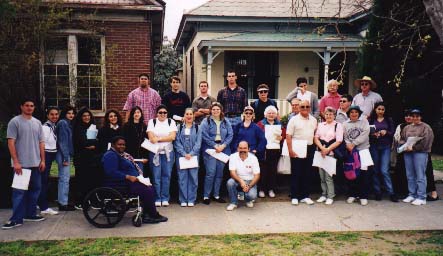 By Jennifer Keledjian Staff Writer
By Jennifer Keledjian Staff Writer
For many of the participants in the class Armenians in Fresno- AS 120T, touring the famous “Little Armenia” in downtown Fresno was remembering old times and forgotten memories. Although many homes, stores and schools no longer remain, the nostalgia of the old Armenian community’s unity and strength sustains.
The tour began by meeting at one of the most significant historical landmarks among the Armenian community, the Ararat Armenian Cemetery, founded in 1885. For some, the initial sight of the hundreds of headstones immediately brought feelings of the old and the dead, but for others it meant elements of culture and heritage, as well as memories of dearly loved families and friends.
The instructor of the class, Barlow Der Mugrdechian noted many well-known Armenian figures who at one time, had a great impact in Fresno’s strong community. Some of these names belonged to the Peters, Seropian, Arakelian, Markarian and Normart families. The tour of Ararat Armenian Cemetery concluded by participants spreading out, trying to locate familiar names and dates of family and friends on surrounding headstones.
The next destination in the tour was the old sites of the Armenian community in downtown Fresno, which is commonly referred to as Fresno’s, “Little Armenia”. Meeting at the prominent Holy Trinity Apostolic Armenian Church marked the start of the official walking tour along Santa Clara street. Standing on Santa Clara and Van Ness streets, class participant Laurie Gooboian talked about the home that her father grew up in located at 521 Van Ness. The old, finely detailed construction of the 1928 home is an example of what many houses looked like in the area around the early part of the century. This home is now being renovated by Gooboian’s brother Christopher and future wife. On Fulton and Santa Clara streets, a sign marks the site of a once historical building which was the oldest Armenian Church in California. The First Armenian Presbyterian Church was part of William Saroyan’s childhood. Saroyan’s quote, “Rev. Knadjian Was the Preacher and I Sometimes Rather Liked Accepting the Instructions of My Mother to Stay for Church After Sunday School,” is on a sign posted at the site.
Continuing on the tour and following detailed maps, Arax Market on Van Ness and L and Suren’s Bakery at Santa Clara and L were noted as places that were once at the center of the large population of Armenians in this distinctive area. Two historical businesses started many decades ago by families within the Armenian community are still successfully operating. Hye Quality Bakery, located at 2222 Santa Clara street, was originally started by Yervant Ganimian in 1957. Hye Quality Bakery, which is now run by Sammy and Paula Ganimian, has grown from a small business to a nation-wide company, distributing baked goods to all parts of the nation.
Our group was given the opportunity to tour the inside of Valley Lahvosh Baking Co, Inc., home of Lahvosh. Started in 1922 by the Saghatelian Family, Valley Lahvosh has remained locally owned and is now run by the 3rd generation of the same family. After the detailed tour of the spacious bakery, each member of the class received samples of the widely known Lahvosh Hearts cracker bread.
Upon concluding the tour, the group arrived at Holy Trinity Apostolic Armenian Church. Our visit included meeting the new Parish Priest, Fr. Vahan Gosdanian, who gave brief comments on the church history. Holy Trinity Apostolic Armenian Church is the second oldest Armenian Apostolic Church in America and stands in the heart of Fresno’s once heavily Armenian populated area as a reminder of tradition and unity, as well as a national historical landmark.
Touring the familiar sites of downtown Fresno’s “Little Armenia”, refreshed many memories of culture, family and of the great bond that unified many Armenians living in this particular vicinity. This area was the center for survival and future dreams. Buildings no longer standing and ones still established both speak of the power and influence that Armenians have in this city.
 Hye Sharzhoom Armenian Action
Hye Sharzhoom Armenian Action